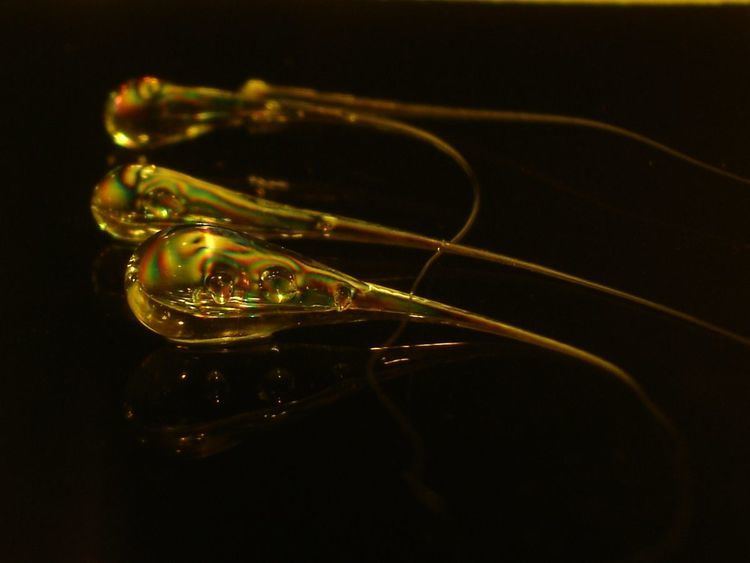 | ||
Prince Rupert's Drops (also known as Dutch tears) are toughened glass beads created by dripping molten glass into cold water, which causes it to solidify into a tadpole-shaped droplet with a long, thin tail. These droplets are characterized internally by very high residual stresses, which give rise to counter-intuitive properties, such as the ability to withstand a blow from a hammer or a bullet on the bulbous end without breaking, while exhibiting explosive disintegration if the tail end is even slightly damaged. In nature, similar structures are produced under certain conditions in volcanic lava.
Contents
The drops are named after Prince Rupert of the Rhine, who brought them to England in 1660, although they were reportedly being produced in the Netherlands earlier in the 17th century and had probably been known to glassmakers for much longer. They were studied as scientific curiosities by the Royal Society and the unravelling of the principles of their unusual properties probably led to the development of the process for the production of toughened glass, patented in 1874.
Description
Prince Rupert's drops are produced by dripping molten glass into cold water. The water rapidly cools and solidifies the glass on the outside of the drop, while the inner core remains molten. When the glass on the inside eventually cools it contracts inwards, producing significant compressive stresses on the surface of the drop while the core solidifies in a state of tensile stress. The quasi-spherical shape of the bulbous head gives it great strength, such that it can be hit with a hammer or struck with a bullet without breaking while the quasi-cylindrical shape of the tail makes it fragile and easily fractured. When any portion of the tail is damaged, the large amount of potential energy stored in the internal structure is released, causing fractures to propagate through the glass toward the head at very high speeds which breaks the entire structure into flakes and powder.
An examination of the shattering of Prince Rupert's Drops by the use of high speed video has revealed that the "crack front" which is initiated at the tail end propagates in a disintegrating drop within the tensile zone towards the drop's head at a very high speed (1.45 to 1.9 km/s [0.9–1.2 mi/s]).
Because of the transparency of glass, the internal stress within these objects can be demonstrated by viewing them through polarizing filters, a technique used in the study of photoelasticity.
History
A scholarly account of the early history of Prince Rupert’s Drops is given in the Notes and Records of the Royal Society of London. Most of the early scientific study of the drops was performed at the Royal Society.
The drops are reliably reported to have been made in Mecklenburg in North Germany, at least as early as 1625. However, it has been claimed that they were invented in the Netherlands (although it has been suggested that they had been known about by glassmakers since the time of the Roman Empire), hence common names for them in the 17th century were lacrymae Borussicae (Prussian tears) or lacrymae Batavicae (Dutch tears). The secret of how to make them remained in the Mecklenburg area for some time, although the drops were disseminated across Europe from there, for sale as toys or curiosities.
The Dutch scientist Constantijn Huygens asked Margaret Cavendish, Duchess of Newcastle to investigate the properties of the drops; her opinion after carrying out experiments was that a small amount of volatile liquid was trapped inside.
It seems clear that Prince Rupert did not discover the drops, but played a role in their history by being the first to bring them to Britain, in 1660. He gave them to King Charles II, who in turn delivered them in 1661 to the Royal Society (which had been created the previous year) for scientific study. Several early publications from the Royal Society give accounts of the drops and describe experiments performed. Among these publications was Micrographia of 1665 by Robert Hooke, who later would discover Hooke’s Law. His publication laid out correctly most of what can be said about Prince Rupert’s Drops without a fuller understanding than existed at the time, of elasticity (to which Hooke himself later contributed) and of the failure of brittle materials from the propagation of cracks. A fuller understanding of crack propagation had to wait until the work of A. A. Griffith in 1920.
Scientific uses
The process for the production of toughened glass by quenching, was probably inspired by the study of the drops, as it was patented in England by Parisian Francois Barthelemy Alfred Royer de la Bastie, in 1874, just one year after V. de Luynes had published accounts of his experiments with them.
It has been known since at least the 19th century that formations similar to Prince Rupert's Drops are produced under certain conditions in volcanic lava. More recently researchers at the University of Bristol and the University of Iceland have studied the glass particles produced by explosive fragmentation of Prince Rupert's drops in the laboratory to better understand magma fragmentation and ash formation driven by stored thermal stresses in active volcanoes.
